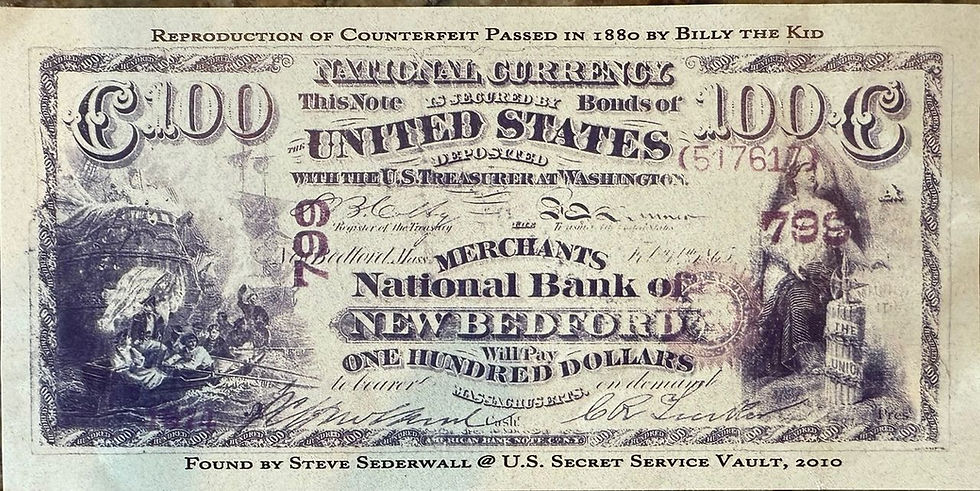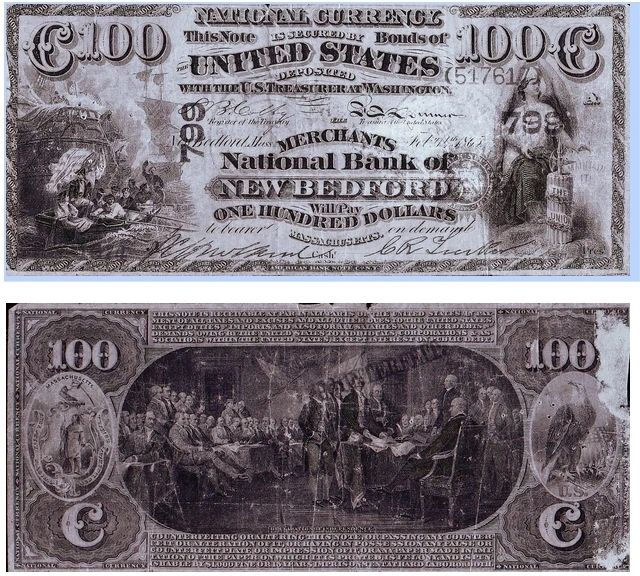Billy’s Grave
- jeremiahslatten
- Jan 19, 2023
- 6 min read
by Ben Doss

A photo of the replica cross made my Colonel Jack Potter. Courtesy of "Billy the Kid's Grave"
"Billy's original grave marker was constructed from a wooden picket from the parade-ground fence. Pete Maxwell had his man saw off a foot or so, and nailed it in a crossbar to the longer piece. Then he printed in crude letters BILLY THE KID, JULY 14, 1881. On the upper left hand corner was a small inscription written in feminine hand: "Dormir Bien Querido" (sleep well, dear one.) Shortly after its installment, it was shot up by a group of drunken soldiers."
Colonel Jack Potter witnessed this original cross being taken by a man named Chauncey, a member of the New England Livestock Co. He took it with him back east and swore to "put it in a museum." Colonel Jack Potter spent years trying to locate the original marker. He was able to trace the shipment out of Las Vegas, but unfortunately, the cross was never seen again. Potter would create a replica of that original cross marker- complete with bullet holes. This had to have happened before 1883 because a reporter for the Las Vegas Gazette visited the grave in late 1882 and stated the grave marker was already gone at that time.
In 1904, the Pecos banks broke open and the Fort Sumner cemetery was flooded. This is often misprinted as occurring in 1906. That is incorrect. State records and several newspaper articles, which were run nationwide, prove the record breaking flood happened in 1904. For two weeks, water stood four feet over the cemetery. However, this did not erase the evidence of the burials. That evidence will be presented later.
In October, 1905, Pat Garrett and Western author Emerson Hough travelled by horse-drawn wagon from El Paso to see the grave of Billy the Kid. Hough described their cemetery visit as follows:

Emerson Hough published his book "Story of the Outlaw" in 1907.
"We learned when we entered the little barbed wire enclosure of the cemetery where the Kid and his fellows were buried. There are no headstones in this cemetery, and no Sacristan holds its records. Garrett had to search in the salt grass and greasewood. "Here is the place," he said at length. "We buried them all in a row. The first grave is the Kid's, and then next to him is Bowdre, and then O'Folliard. There's nothing left to mark them. Even the headboard which once stood at the Kid's grave- and which was once riddled with bullets by cowards who would not have dared to shoot that close to him had he been alive- was gone."
*Garrett would've been able to locate the graves based on the mounds. One year after the great flood and Garrett could still locate the three graves.
"Between January 2, 1863, and February 1, 1868, twenty-two military burials were recorded in the old Fort Sumner cemetery, the final was Private William Epple, Third Cavalry. One of the twenty-two was actually a civilian. In January of 1906, Charles W. Dudrow was contracted to move those twenty-two burials to the Santa Fe National Cemetery. Dudrow accessed the military burials from official Fort Sumner records. Although most gravestones had washed away, Dudrow had no issues finding those twenty-two mounded burials, nor locating the mounds of Billy, Charlie, and Tom. On March 8, 1906, all twenty-one soldiers were re-buried with military honors in the Santa Fe National Cemetery. Dudrow provided a hand-drawn map showing locations of the soldiers graves, as well as Billy's and his two "gang members." This is the best historical documentation for the location of the graves."
In either 1924 or 1925, Western writer Fred E. Sutton was seeking information on Billy the Kid. He travelled to Fort Sumner and sought out Deluvina Maxwell, who lived in a one-room adobe not far from the old fort.

The concrete curbing placed around the graves, and a slab of concrete poured over Billy's grave (far right)
"Old Deluvina volunteered to show the writer, the grave of "her boy." We walked to the rude gate or entrance to the yard, from where there was a path running among the graves, and she said: "Billy was buried three feet west of this path and thirty-one steps from the gate." We stepped the distance and she pointed to a

Deluvina Maxwell later in life.
sun-baked, cracked and desolate spot of ground about six feet by three, as bare as it could be made, with grass and weeds growing to its very edge and then utterly refusing to grow further. "It has been this way always," she said, "and I don't see why things won't grow over Billy, for he was a good boy. "
In 1926, only six months after the release of Walter Burns' "Saga of Billy the Kid" an outcry began over marking Billy's grave. By August of 1927, a marker had been erected- but it was in the wrong spot. "In

This is not where Joe Grant is actually
buried. In the background you can see
Billy's cage. Just to the left of the cage,
approximately 10-15 feet, is where Joe
Grant is actually buried. This wooden
stone was created most likely as a
tourist attraction.
the old graveyard, now overgrown with range grass, there was a marker bearing the name of Billy the Kid. The story here is that the marker was misplaced and that, by a grim irony of fate, it adorns the grave of Joe Grant, one of the Kid's victims via the sixshooter. The Kid's own grave is nearby."
*This second marker that was misplaced was described as a "dignified octagonal wooden marker, suitably inscribed with Billy the Kid's name and a few dates concerning him."

Left to right: Charles Foor, Jesus Silva, Vicente Otero, and Paco Anaya.
In April of 1930, four men came together to locate Billy's grave. They were A.P. Paco Anaya, Jesus Silva, Vicente Otero, and Charles W. Foor. Three of these men knew Billy personally. Charles Foor moved to Fort Sumner about two months after Billy was killed.

By mid-May 1930, the three graves of Billy, Bowdre, and Folliard (O'Folliard) were surrounded by concrete curbing, and a concrete slab was poured over Billy's grave. The cemetery grounds were enclosed in a wire fence. The construction was the work of J.T. Perkins.
"In late February, 1931, a large granite marker was erected over the graves of Billy, Bowdre, and Folliard (O'Folliard) at the location identified by Anaya, Silva, Otero, and Foor. The order for the stone had been placed in late October, 1930. This is the stone that still marks the graves today. The word PALS was inscribed during its creation."
"On March 23, 1940, Billy received his own individual marker. It was donated by James Noah Warner, who owned a quarry and monument business in Colorado. The new marker was made of dark blue marble and stood 23 inches high, 16 inches wide, and 6 inches thick. It weighed 200 pounds. This is the stone that would be stolen twice. First in August of 1950, then again in February of 1981. The first time it was gone for 26 years. The second for only 16 days."
By mid-May 1930, the three graves of Billy, Bowdre, and Folliard (O'Folliard) were surrounded by concrete curbing, and a concrete slab was poured over Billy's grave. The cemetery grounds were enclosed in a wire fence. The construction was the work of J.T. Perkins.
"In late February, 1931, a large granite marker was erected over the graves of Billy, Bowdre, and Folliard (O'Folliard) at the location identified by Anaya, Silva, Otero, and Foor. The order for the stone had been placed in late October, 1930. This is the stone that still marks the graves today. The word PALS was inscribed during its creation."
"On March 23, 1940, Billy received his own individual marker. It was donated by James Noah Warner, who owned a quarry and monument business in Colorado. The new marker was made of dark blue marble and stood 23 inches high, 16 inches wide, and 6 inches thick. It weighed 200 pounds. This is the stone that would be stolen twice. First in August of 1950, then again in February of 1981. The first time it was gone for 26 years. The second for only 16 days."




Comments